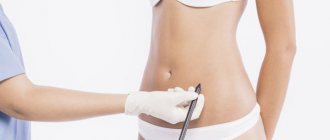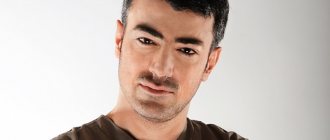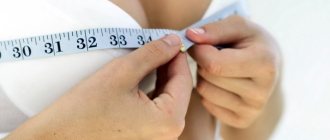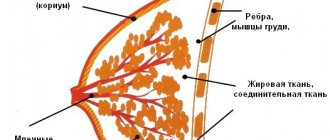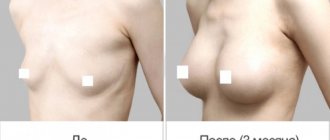Sarukhanov Georgy Mikhailovich is a plastic surgeon with extensive experience in performing plastic surgery on the chest. More than 3,000 different types of mammoplasty have been performed. Proficient in many techniques for breast augmentation, reduction, and lifting. He is actively involved in scientific activities, has many publications in specialized journals, and regularly makes presentations at Russian and international conferences and congresses.
Georgy Mikhailovich, we would like to ask you a few questions, as a plastic surgeon who has the absolute authority of mammoplasty, who has performed a huge number of similar operations and, in our opinion, understands the psychology of patients who have decided to undergo breast plastic surgery. The popularity of mammoplasty has not subsided over the years. Why do you think women undergo such operations?
From time immemorial, beautiful female breasts have been considered one of the main advantages and a source of pride for the fair half of humanity. The female body has always been an inexhaustible source of inspiration and an eternal muse for all artists, poets and musicians. Of course, the canons of the beauty of female breasts have changed over time and large, lush breasts have not always been in “fashion”. However, the shape of the breast itself, regardless of its size, is, in my opinion, the main criterion for assessing women and the motivating factor for contacting us, plastic surgeons.
Perfect breasts
Do you, as a man, and not a plastic surgeon, support this desire of women? Have you ever had a person come to you with a request to enlarge your breasts, for example, to size 6 or reduce them to size 1? How do you feel about such wishes of patients?
Probably every woman wants to please not only men, but also herself, first of all. After all, the desire for harmony and perfection is a natural desire. I don’t see anything “reprehensible” in the fact that you want to be beautiful and loved, to live in “harmony” with yourself, as they say. Of course, we are all different in our tastes, views and desires. Therefore, in our practice, we sometimes encounter “non-standard” requests. And if the proposals, as you say, “increase to size 6 or reduce to size 1,” are quite adequate, justified, and most importantly, will not harm health or lead to serious complications, then we will meet you halfway and agree to perform the operation .
Which type of breast surgery do you do best?
The operation that succeeds best is the one that you approach thoughtfully, having weighed everything and choosing the right tactics and methods. The main success is obtaining a result that not only pleases you as a performer (and most surgeons are quite self-critical of the work done), but also brings great joy and satisfaction to the patient. Then you feel that it was not in vain that you chose such an interesting and unique specialty...
Okay, then let's look at each type of breast surgery separately.
BREAST SURGERY: ENDOPROSTHETICS
It is known that breast augmentation surgery with implants is most often performed. How do you explain the popularity of this method?
In my opinion, such popularity is caused primarily by the demand for the “availability” of sufficient breast volume (size), a beautiful neckline, and the desire to be like the girls on the covers of glossy magazines, TV screens, and Internet pages. After all, the entire beauty industry is built on the slogan “if you are beautiful, you are successful.” And there is probably the lion's share of truth in this.
Georgy Mikhailovich, do patients usually come for breast augmentation consultations themselves or with their “other halves”? How do men generally perceive this operation, are they usually for or against?
In most cases, ladies come without gentlemen; after all, this is an “intimate” conversation - not everything needs to be known to the “soul mate.” There must be some kind of secret... But there are also patients whose size and shape are “chosen” (as sponsors and customers rolled into one) by their companions. In such cases it is quite difficult. After all, in the end, going through the operation, the postoperative period and “wearing”
new breasts for the patient, not her boyfriend. We have to look for compromises that suit all sides of the debate... Usually it is desirable for men, if he has the final word, for their companion to have a “decent” volume. Apparently this serves as another consolation for one’s ego and a source of pride for one’s “soul mate.”
There is a fairly large dimensional grid of implants. If a girl wants to get the largest implant available, will her breasts sag under its weight? What size implants are preferable to install to avoid breast sagging?
Of course, when choosing the volume of implants, we take into account the wishes of the patient as a “customer”. But as doctors and professionals, we must focus not only on the wishes, but also on the patient’s initial data. The principle “any whim for your money”, in my opinion, is not appropriate here. An experienced doctor must predict not only the possibility of obtaining the result desired by the patient, but also assess the possible risks and consequences (early or late)
in case of inadequate choice of implant size. Significantly exceeding the permissible maximum volume of the implant will subsequently have a negative impact on the shape of the breast, leading to thinning of the integumentary tissues of the mammary gland (their atrophy), as well as gravitational ptosis (dropping of the implants along with the gland).
Well, we can’t help but ask the most popular questions: Can an implant burst when flying on an airplane? Does the risk of getting cancer increase after getting implants? Is it difficult to damage the implant? Do I need to change the implant 10 years after its installation? If the gel leaks out, what happens to the surrounding tissue?
Modern implants do not burst or “explode” on an airplane unless they are pierced with a sharp object. But, you see, this happens extremely rarely. It is indeed very difficult to rupture the shell of the latest generation implant. You've probably seen a video about how prosthetics can withstand not only the weight of an adult standing on them, but even the weight of a car running over him. Most implant manufacturers provide a lifetime guarantee for free replacement in case of spontaneous rupture of the prosthesis, thus confirming the strength of their shell. Today, we do not tell patients that they need to replace their implants every 10-15 years on a routine basis. Of course, this does not apply to the need for replacement
implants in case of any complications and deterioration in breast shape in this regard. As for the leakage of silicone gel into the surrounding breast tissue in the event of implant rupture, this situation requires its urgent replacement. Therefore, patients should be very careful about any changes in the shape of the breast, its consistency, and be sure to promptly contact the operating doctor if such situations arise.
Is it dangerous to sleep on your stomach after breast replacement?
For the first 2-3 months, we do not recommend that patients lie on their chest and put excessive pressure on the prosthesis. Of course, such recommendations are not given because there is a danger of implant rupture. In the early stages after surgery, until the shell around the prosthesis has formed, there is a danger of their displacement or rotation in case of inadequate influence on them. After this period, there are no prohibitions or restrictions on physical pressure on the prosthesis or playing sports.
How does the patient feel after the implant is installed? Can the rehabilitation period after this operation be called difficult?
I cannot call rehabilitation after breast replacement difficult or very difficult. Painful symptoms are probably more noticeable after installation of implants under the muscle than under the gland, and may also vary in intensity in patients depending on the density and elasticity of the tissues surrounding the prosthesis. Women who have given birth with “prepared”, slightly stretched breast tissue report less intensity of pain after surgery
on the chest than young, nulliparous girls with small, firm breasts. The peak of swelling and pain occurs during the first 3-5 days, then these symptoms decrease significantly and by the end of the second week, patients stop complaining of pain and a feeling of fullness in the chest. Experience shows that women endure all postoperative difficulties quite easily, because... they already see beautiful, full breasts and their dreams of a chic neckline, beautiful lingerie (without damned foam pads and other tricks) are becoming a near reality. And happiness heals!
How often is breast replacement combined with other types of plastic surgery? Which ones?
I would say often. The advantage of combined breast surgery is that the patient does not need to undergo anesthesia or a rehabilitation period twice. Yes, and financially it is more profitable, which is not unimportant. Most often, breast augmentation with implants is combined with facial plastic surgery, leg augmentation, and abdominoplasty.
It is known that the gel inside implants has different densities. Does this mean that breasts after surgery may feel different from natural ones?
Indeed, the gel can differ in density in round and drop-shaped (anatomical) implants: in round implants the gel is softest, in drop-shaped implants it is more cohesive (dense). On the one hand, the softness of the gel is a plus (breasts feel softer, more mobile, more natural to the touch), but on the other hand, it is a minus (there is a greater likelihood of contouring of implants, the formation of waves and ripples, especially in
patients with minimal tissue coverage). Teardrop-shaped implants hold the shape of the breast better and “support” the tissues, they give less waviness and palpation of the contours, but still, they are a little firmer to the touch. The doctor’s task is to tell about all the pros and cons of certain implants and come to some kind of compromise solution, taking into account the assessment of the patient’s integumentary tissues, wishes and the original shape of the mammary glands.
BREAST SURGERY: BREAST LIFT
Now let's talk about the next most popular breast surgery - breast lift. If with a periareolar lift the scars look quite organic (can be attributed to the structure of the areolas), then with a vertical or anchor lift there is no way to hide them. Is it possible to avoid a breast lift by installing implants, thereby filling sagging breasts?
It is possible, but not always. There must be a certain correspondence between the filler (the volume of “collected” gland tissue or implant) and the so-called “skin cover”. Figuratively speaking, the size of the pillowcase (“case”) should correspond to the size of the pillow. If we place a small pillow in a large pillowcase, we need to sew it adequately to the size of the pillow. And vice versa - if the pillow is too large, then it will not fit into a small pillowcase or will be very wrinkled. In addition, do not forget that the periareolar lift has limited indications. If the excess skin is significant, then when matching (suturing) the outer and inner edges of the incisions around the areola, significant corrugation and folding of the skin can form,
and the natural cone of the breast may also be lost. In such cases, the breasts may appear flattened, resembling a tomato. In addition, a large load on the sutures due to a significant discrepancy between the diameters of the outer and inner “circle” (areola) can lead to the formation of coarse visible scars. In my opinion, a naturally teardrop-shaped breast with thin scars will look much more beautiful than a flattened, tomato-shaped breast with rough, noticeable scars. Our experience shows that vertical scars often look less noticeable and thinner than scars around the areola.
Is a breast lift technically difficult? How soon can a young surgeon begin performing this operation?
Any breast surgery can seem complicated unless you have some experience in performing it. If we talk about a “banal” enlargement of a symmetrical, small, “correct” breast structure, then in technical terms, endoprosthetics is easier and faster to perform than “collecting and tightening” a medium-sized sagging breast. Maybe you're right. It is better to start mastering mammoplasty techniques with breast augmentation with implants, and only then, as you gain experience, proceed to mastopexy (lift without implants) and reduction techniques - breast reduction. It is difficult to talk about any specific time frame (a year, two, three, etc.) - it depends on the abilities of the surgeon, his knowledge and accumulated experience. The famous American surgeon Dennis Hammond, when asked similar questions, jokingly answers something like this: “For five years I mastered one breast..., another five years - the second.” As they say - “Every joke has a grain of joke, the rest is true.”
Will another mastopexy be necessary in a few years?
All tissues of the human body undergo changes throughout life, and, unfortunately, not for the better. We live on earth and are subject to the forces of gravity - no one has yet canceled it. You need to understand that with age, due to various reasons (weight fluctuations, hormonal changes, deterioration of the elastic properties of tissues, pregnancy
Perfect breasts
and breastfeeding, etc.) the shape of the breast also changes. For one young lady, she “loses weight” and sag, for another, she increases in size. It is very difficult to predict the pace and options for breast changes, and accordingly answer the question of whether correction will be needed or not. In order to somehow predict the preservation of a good result, you need to take into account a lot of influencing factors: what kind of lifestyle she leads, how elastic her skin is, how compact and dense the gland itself is, and much, much more. It is quite rare for patients to come to us for repeat mastopectomy exactly in the scope of the previous intervention. But there are also those who, after a mastopexy (lift), after some time, seek breast augmentation for reasons of insufficient volume or unstable shape.
Another traditional question: How does the patient feel after a breast lift? Can the rehabilitation period after this operation be called difficult?
I would say so. After a breast lift or reduction, compared to endoprosthetics, there is no particular pain. A slight feeling of fullness, discomfort - nothing more. Naturally, after this operation, bruises and swelling may persist for 10-14 days, but this takes into account that the patient does not help her body with rehabilitation procedures. We really care
about our patients and try to make the postoperative period as easy as possible for them. Therefore, the doctors of our clinic created an original course of restorative procedures, which is aimed at the speedy resolution of bruises and swelling and healing of wounds. And yet, you need to know that, despite the uncomplicated postoperative period, the final shape of the breast after lifting or reduction is formed by 3-4 months.
Plastic surgeon Sarukhanov Georgy Mikhailovich
Clinic where the surgeon works:
|
Education 1985 - graduated from the Tashkent State Medical Institute with a degree in general medicine;
Advanced training courses 1993 - specialization in plastic and reconstructive microsurgery at the Russian Medical Academy of Postgraduate Education (on-site cycle, Tashkent); 1992 - 1993 specialization in cosmetic surgery at the Center for Aesthetic Surgery in Tashkent; 1993 - 1995 specialization in cosmetology at the Department of Oriental Medicine and Cosmetology at the 2nd Tashkent State Medical Institute; 1996 - Course of plastic and aesthetic surgery of the German Association of Plastic Surgeons in Russia (St. Petersburg); 1998 - 1999 participation in international congresses on applied aesthetics in Russia (Moscow) 2003 - advanced training courses “Fundamentals of plastic, reconstructive and aesthetic surgery at the Medical Academy of Postgraduate Education (St. Petersburg); 2003 - certification in the specialty “surgery” at the Military Medical Academy (St. Petersburg); 2005 - 2007 participation in the eighth, ninth, eleventh intensive courses in plastic and reconstructive surgery, conducted under the auspices of OPREH (Moscow); 2007 - participation in an intensive course on mammoplasty under the auspices of the American Society of Plastic Surgeons (Moscow). Practical activities
1995 - 2000 surgeon-cosmetologist of the Center for Aesthetic Surgery (Tashkent); 2000 - 2003 Head of the Department of Surgical Cosmetology of the Center for Aesthetic Surgery (Tashkent); 2003 - 2010 Head of the Department of Plastic Surgery at the Medi-Aesthetic Clinic (St. Petersburg). From 2010 to the present, owner and head of the plastic surgery department of the Abrielle clinic (St. Petersburg).
Operations performed by the surgeon:
Plastic surgery
Abdominoplasty (tummy tuck) - from 25,000 rubles Lipofilling - from 12,000 rubles Eyelid surgery - from 28,500 rubles Breast augmentation - from 70,000 rubles Breast reduction - from 98,000 rubles Breast lift - from 45,000 rubles Facial plastic surgery - from 15,000 rubles
If you would like to add information about a plastic surgeon to our directory, please contact us at the coordinates indicated here.
Latest forum topics on our website
- Natalya / How to properly make a gelatin mask?
- Mrs._Smith / Badly sunburned! What to do?((
- Ice / Is it necessary to combine fitness classes with a diet?
- Antonova / What can be used for hair loss?
- Radio operatorKat / Who was on a protein diet?
Share
BREAST SURGERY: BREAST LIPOFULLING
The third most popular breast surgery is lipofilling. The Abrielle Clinic and you personally, Georgy Mikhailovich, have made a big step in the development of this technique. Today you are leaders in the field of lipofilling. They say that you work miracles, and your fat survives by 80-90%, which is still unattainable for most surgeons. This is true?
Thank you for your flattering review. We have indeed devoted many years to developing and improving the methods of lipofilling of the face and body, including fat transfer to the mammary glands. And at the moment we have enough results that we can be proud of. The survival rate of transplanted fat depends on many factors (not only the “hands” of the surgeon and the technique of performing
operations), including from the individual, more precisely, his metabolic processes in the body. However, despite the partial resorption of the transplanted fat, there is now an alternative for those wishing to enlarge their breasts. The only question is how significantly the patient wants to enlarge her breasts; she has sufficient donor zones from which fatty tissue could be taken. On average, we can enlarge breasts 2 or more times in one procedure using lipofilling. If the patient wants a larger increase, we suggest repeating the procedure. And recently, for those who want to get “everything at once,” as they say, we often offer a combination of breast augmentation with implants and lipofilling. This operation has a number of advantages. But this is a topic for another discussion.
Georgy Mikhailovich, you are a regular lecturer at various events dedicated to plastic surgery, and recently the Abrielle clinic organized its own school. Are you not afraid to share your knowledge with your direct competitors?
You know, I often get asked this question. No, I'm not afraid to share my knowledge. Another thing is how soon the “recipient” of this knowledge will be able to implement it into their practice. From our own experience, we know how difficult it is to master a new technique that gives excellent results in “strange” hands. And the process of “sharing” our knowledge does not need to be viewed one-sidedly - we receive feedback from colleagues in the form of questions, discussions and new ideas. And this makes you think, sometimes rethink or improve seemingly proven methods. And there is enough work and patients for everyone. After all, the popularity and demand for our specialty is growing from year to year.
So, let's get back to lipofilling. What is this breast enlargement method?
Fat grafting is a fat grafting operation. That is, you can take adipose tissue from the abdomen, flanks (sides), back, legs and transplant it into the area of both the mammary glands, the face and neck, buttocks, legs, and hands. That is, in one surgical intervention we solve several problems at once: we improve the contours of the body as a whole (with the help of liposuction you can create a thin waist, improve the shape of the hips and legs, remove fat deposits on the back, etc.) and enlarge the mammary glands. In recent years, more and more patients want to enlarge their breasts with their own fat, realizing the advantages of this method - naturalness, naturalness, the absence of a foreign body and incisions.
Liposuction areas are indicated in pink, lipofilling in yellow.
Can fat not take root?
This is absolutely impossible if the patient adheres to the recommendations of his surgeon. I repeat, the patient’s own tissue is transplanted, which is absolutely safe, does not migrate, does not cause irritation or other complications, simply because it is already part of the body. But the engraftment process itself takes several months. At this time you need to be very careful
Regarding lipofilling areas: do not expose these areas to pressure, avoid hot procedures (baths, saunas), heavy physical activity for 2-3 months.
And if a girl smokes, is there a risk of greater fat absorption?
Based on practice, I can say that rehabilitation is easier and faster for patients without bad habits, so at least 2 weeks before surgery and during the rehabilitation period, I recommend reducing the number of cigarettes smoked. After all, smoking leads to spasm of small capillaries, which means the conditions for fat engraftment worsen.
Is it possible to combine lipofilling with other types of breast surgery? Will the fat leak out?
No, the fat will not leak out. Lipofilling and breast replacement are performed at different levels - in different planes. For example, the prosthesis is placed under a gland or under a muscle. And fat is injected superficially - into the subcutaneous fat above the gland tissue itself (parenchyma). If we perform a gland lift, we often do not affect the parenchyma, but only remove excess skin. Accordingly, we can inject fat both under the mammary gland and subcutaneously. Sometimes we perform lipofilling over a previously installed implant, placing it in the subcutaneous fat layer. This allows you to better hide the contours of the implants, reduce the appearance of waviness, increase volume, and create a beautiful neckline.
It turns out that lipofilling can completely replace augmentation with implants?
No, I think it is unlikely that this will happen in the near future. So far, our knowledge and skills are not enough to ensure that we can guarantee 100% survival of any volume of transplanted fat. But work in this direction is going on all over the world. In addition, not all women have enough fat tissue for transplantation, and not all patients who want to significantly enlarge their breasts in one procedure will agree to several lipofilling sessions.
How is rehabilitation after breast lipofilling?
It should be taken into account that lipofilling involves lipoaspiration (liposuction), that is, this is a 2 in 1 operation, which means that bruises and swelling will be both on the chest and in the areas of fat tissue sampling, but they go away quite quickly. When performing rehabilitation procedures, bruises and swelling usually disappear by the end of this course, which usually involves 5-6 procedures, starting from the first postoperative day. The advantage of this operation is that it leaves no scars and the breasts look completely natural.
About Me
Plastic surgeon, doctor of the highest category, candidate of medical sciences.
Chief physician at the Abrielle Plastic Surgery Clinic. He has 20 years of general surgical experience. Experience in plastic surgery since 1995. He is a permanent full member of the International Society of Aesthetic Plastic Surgeons (ISAPS) and the Society of Plastic, Reconstructive and Aesthetic Surgeons of Russia (OPRESH). Holder of international and Russian certificates in aesthetic, plastic and reconstructive surgery. Constantly participates and acts as a speaker at Russian and international symposia and congresses. He is the author of more than 40 scientific papers.
Since 2015 – Associate Professor of the Department of Plastic Surgery at PSPbSMU named after. acad. I.P. Pavlova.
Information about the education and professional activities of a plastic surgeon:
- 1998-1999 – participation in international congresses on applied aesthetics in Russia (Moscow, Russia);
- 2003, 2008 – advanced training courses “Fundamentals of plastic, reconstructive and aesthetic surgery at the Medical Academy of Postgraduate Education (St. Petersburg, Russia);
- 2003, 2008 – certification in the specialty “surgery”, “maxillofacial surgery” at the Military Medical Academy (St. Petersburg, Russia);
- 2005-2007 – participation in the eighth, ninth, eleventh intensive courses in plastic and reconstructive surgery, conducted under the auspices of OPREH (Moscow, Russia);
- 2006, 2008, 2010 – participation in the IV – VI international course on plastic surgery (Ekaterinburg, Russia);
- 2007 – participation in an intensive course on mammoplasty under the auspices of the American Society of Plastic Surgeons (Moscow, Russia);
- 2007-2010 – participation in international congresses under the auspices of ISAPS (Chicago, San Francisco, USA);
- 2009 – participation in the 11th European Congress under the auspices of ESPRAS (Rhodes, Greece);
- 2010 – speaker of the II educational course of the Russian national section of ISAPS on the topic “Augmentation mammoplasty”;
- 2010 – participant of the 1st International School of Plastic Surgery and Cosmetology (Moscow, Russia);
- 2011 – participant of the First International ISAPS training course in plastic surgery (St. Petersburg, Russia);
- 2011 – participant of the 9th international course of plastic and aesthetic surgery on the topic “Minimally invasive facelift methods” at the Javier de Benito Institute (Barcelona, Spain);
- 2011 – participant of the international forum on aesthetic medicine “Siberian Vacations” (Baikal, Russia);
- 2011 – participant of the International Congress of Plastic and Reconstructive Surgery (Chicago, USA);
- 2011 – participant of the ΙΙ International School of Plastic Surgery and Cosmetology (Moscow, Russia);
- 2012 – moderator of the V educational course of the Russian national section of ISAPS on the topic “Transplantation of autologous fat. Modern achievements and unsolved problems”;
- 2012 – moderator of the international course on plastic surgery and minimally invasive rejuvenation techniques (St. Petersburg, Russia);
- 2012 – participant of the seventh international course on plastic surgery on the topic “Rejuvenating facial surgery, body contouring” (Ekaterinburg, Russia);
- 2012 – moderator of the international training seminar “Complex cases of aesthetic mammoplasty” (Moscow, Russia);
- 2012 – certification in the specialty “Plastic Surgery” at the National Educational Institution of Higher Professional Education of the Samara Medical Institute “Reaviz” (Russia);
- 2013 – speaker at the seventh professional forum “The Art of Plastic Surgery”;
- 2013 – speaker at the 11th World Congress on Anti-Aging Medicine (Monte Carlo, Monaco);
- 2013 – speaker at the III International School of Plastic Surgery and Cosmetology (Moscow, Russia);
- 2014 – speaker at the VIII Professional Forum “The Art of Plastic Surgery” (Moscow, Russia);
- 2014 – speaker at the V International ISAPS Symposium on Plastic Surgery and Cosmetology “New Horizons in Aesthetic Medicine” (Moscow, Russia);
- 2014 – participant of the VIII International Course of S.V. Nudelman in plastic surgery (Ekaterinburg, Russia);
- 2014 – speaker and moderator of the training course in the Live Surgery & Injection format “Advanced aesthetic rhinoplasty, otoplasty and facial contouring.” (Saint-Petersburg, Russia);
- 2015 – speaker at the International Congress on Aesthetic Surgery and Cosmetology IMCAS 2015 (Paris, France);
- 2015 – speaker at the International Conference “New Technologies in Plastic and Reconstructive Surgery” (Moscow, Russia);
- 2015 – speaker of the V International training course on plastic surgery (St. Petersburg, Russia);
- 2016 – speaker at the forum of plastic surgeons in Moscow as part of the XV Anniversary International Symposium on Aesthetic Medicine (Russia);
- 2016 – participant of the Bryan Mendelson Course “Innovative methods of facial rejuvenation” (St. Petersburg, Russia).
Download NULLed WordPress Themes
Download NULLed WordPress Themes
Download NULLed WordPress Themes
Download WordPress Themes
download udemy paid course for free

